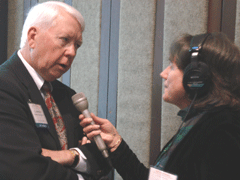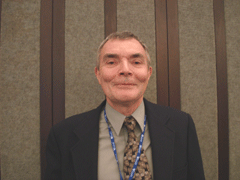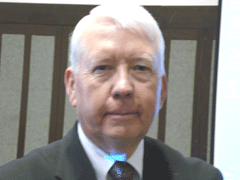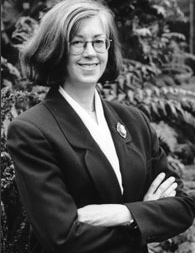Healthy Food?
Air Date: Week of February 22, 2008

LOE's Helen Palmer interviews with Charles Arntzen. (Photo: Kathleen O'Neil)
Some scientists say the best place to grow the next generation of pharmaceutical drugs is within food crops. Living on Earth’s Helen Palmer talks with Steve Curwood on recent scientific advancements in all things food and pharma.
Transcript
CURWOOD: It’s Living on Earth. I’m Steve Curwood.
The obesity epidemic is spreading around the world. According to one report more than 300 million people are obese, and closer to home about 60 percent of Americans are overweight. Over-eating and chronic diseases associated with obesity are literally killing us.
But as Living on Earth’s Helen Palmer recently learned- food could also be our salvation. Helen joins me now in the studio.
Hi Helen, seems to me that food is the problem. How can it also help?
PALMER: Well, Steve- you know it was Hippocrates, the founding father of modern medicine—
CURWOOD: Sure, ‘first do no harm’—
PALMER: Right. He also said, ‘Let food be your medicine and medicine be your food.’ And a number of researchers are taking Hippocrates at his word, and updating that with a healthy dose of modern technology. Take something called Pharming- that’s Pharming with a PH.
CURWOOD: PH? You mean, as in ‘pharmacy,’ right?
PALMER: Exactly - that’s where researchers engineer plants to “grow” pharmaceutical drugs. It’s absolutely fascinating Steve - and I’ll get to that in a bit but first let me you about the work Henry Thompson’s doing. He’s a cancer researcher at Colorado State University.
Thompson says that the underlying all chronic disease you know, diabetes, heart disease, cancer - are similar metabolic disruptions.
CURWOOD: Metabolic, you mean, the way we metabolize or use our food?
PALMER: Yeah, sort of. What he says is that in these diseases, at the cellular level, glucose – sugar – is being handled differently, and that causes inflammation, and that inflammation causes damage. So Dr Thompson’s prescription - veggies to prevent damage in the first place.

Henry Thompson of Colorado State University, Fort Collins. (Photo: Helen Palmer)
PALMER (ON TAPE): So basically if we eat the right foods we might not get sick in the first place?
THOMSON: That’s exactly right.
CURWOOD: Sort of a physician, farmer and chef. Heal thy self?
PALMER: Right. What Professor Thompson says is that plants have had to fight off microbes and pests and environmental stresses – and they’ve developed powerful chemicals to help – and those same chemicals actually protect within the human cells.
CURWOOD: So what kinds of plant foods has he been studying?
PALMER: Well he’s been looking at the staples, you know, crops like rice, wheat, corn, potatoes and Thompson’s done a lot of research testing various types of beans on mice to see which varieties protect them best against cancer.
THOMSON: This is the common bean, so an example would be black bean or kidney bean. They differ in their health promoting activity relative to cancer. It turns out so far we’ve found that dry beans from the Andean center of domestication seem to have more health benefit, but all beans are good so what’s the advice again? Half a cup a day, every day.
CURWOOD: Beans…beans…good for the heart.
PALMER: Yes indeed. But by the way those Andean varieties include kidney, black and cranberry beans. Thomson says he’s found that the variety matters with all food groups, so say Red Delicious or Granny Smith apples or Peruvian Purple or Yukon Gold potatoes can have different beneficial effects. Right now though there isn’t enough hard evidence to say you should eat one variety rather than another. He says eat lots of varieties and many different food groups.
CURWOOD: So this means my grandmother was right, eat my cabbages and broccoli and the squashes and tomatoes?
PALMER: Yes and don’t forget your rutabagas, and the onions and the garlic!
CURWOOD: Okay. Well Helen, tell me now about the Pharming with a ph? Seems to me that growing drugs isn’t particularly new. There are lots of familiar therapies that come from plants, what the heart drug digitalis from foxglove, or aspirin from willow trees.
PALMER: That’s right, but those were discovered accidentally. The new PH pharming is about creating designer plants that can produce drugs with specific effects. Now biotech companies are doing something like this, but it’s incredibly costly - hundreds of millions of dollars - and they grow what are called “biologics” they’re vaccines, you know, growth hormone, cancer drugs. They grow them in cell cultures or fermentation vats. The new pharmaceutical pharming will actually grow plants in greenhouses.
CURWOOD: And this is going on right now, drugs are being grown?
PALMER: Well, they are being grown but the technology’s still only experimental, they’re not approved. But I did speak to one researcher though, Charles Arntzen from Arizona State University. He says he’ll have a plant-grown vaccine in human clinical trials this year. He started with potato plants and now he’s working on tobacco.

Charles Arntzen of Arizona State University, Tempe. (Photo: Kathleen O'Neill)
PALMER: Yeah it’s ironic eh? Right now drug companies add a little bit of viral DNA to yeast to make some of these advanced vaccines so Arntzen figured well, let’s use plants.
ARNTZEN: If Merck could make it work with yeast, I just said, “Well, let’s put the same gene into a plant like tobacco or tomatoes or potatoes” and the same gene works the same way. What we then did was took the some of the plant tissue and fed it to mice and lo and behold the virus-like particles stimulated the immune system because we have immune effector sites in our gut and when those effector sites saw the virus-like particle - bam we click on our immune system, and then we got approval from the F.D.A. to take this into humans and sure enough the same thing works in people. You eat a raw potato for example that’s got the genes for the virus-like particle for Hepatitis B and the human volunteers got a wonderful immune response which is what we want for a good vaccine.
CURWOOD: Yeah, but Helen, c’mon eating a raw potato? I mean, how many of these things do I have to eat to get vaccinated?
PALMER: Well Dr. Arntzen discovered you’d have to eat a potato the size of a tennis ball to get a high enough dose. But don’t worry, he’s now working on a simpler scheme. He takes a tiny bit of the DNA with the human disease and puts that it into a tobacco virus, and then he puts that virus into a tobacco plant and it grows like crazy. And there it is – a human vaccine.

LOE's Helen Palmer interviews with Charles Arntzen. (Photo: Kathleen O'Neil)
PALMER: No, no. It would be harvested and made into a shot. As I said, it’s still experimental but it works. Dr Arntzen’s transferring this technology to India so they can make a low-cost hepatitis B shot – and he’s using the same approach to make a vaccine for the Norwalk virus.
ARNTZEN: It’s the cruise ship diarrhea. It’s closed hospitals in the U.S. and the cost of decontaminating say a hospital ward is incredible. So there’s need for a vaccine. Noroviruses do not replicate in anyone but humans so we found that by taking a gene out of the noroviruses we can put it in plants and we’re now doing the experiments and I hope to be in human clinical trials in 2008 with our first tobacco derived norovirus vaccine to test its efficacy.
CURWOOD: You know, this all sounds really great Helen but there’s gotta be a catch. I can hear a ‘but’ coming along—
PALMER: Oh yes Steve, there’s a but. But it’s not about what Dr. Arntzen is doing. First of all, he’s not using a food crop, you know, anything we eat. And then, he’s not genetically modifying a plant. He’s working in secure greenhouses. So those are all protective things. But - and here’s the but - there are concerns about other kinds of pharmaceutical pharming where scientists might manipulate genes, say in corn or rice or some other food crops. That really worries Margaret Mellon of the Union of Concerned Scientists.

Margaret Mellon, Director of the Food and Environment Program, Union of Concerned Scientists. (Courtesy of the Union of Concerned Scientists)
CURWOOD: I’d say. I wouldn’t want a heart drug in my yogurt and granola in the morning.
PALMER: Exactly. I wonder if you remember Starlink corn? That was genetically modified corn that was only approved for animals and it ended up in tortillas. Well that cost farmers and food companies billions.
CURWOOD: So what about rules for this stuff, especially after that fiasco?
PALMER: Well, the Union of Concerned Scientists says there should be a total ban on genetically engineering any food plant to produce drugs, and actually Steve, the USDA is expected to make rules for Pharmaceutical pharming by the end of this year
CURWOOD: Well we’ll keep track of that then won’t we.
PALMER: Indeed.
CURWOOD: Living on Earth’s Helen Palmer. Thanks so much.
PALMER: Any time Steve.
Links
A Growing Concern: Protecting the Food Supply in an Era of Pharmaceutical Industrial Crops
The Economics of Pharmaceutical Crops
Living on Earth wants to hear from you!
Living on Earth
62 Calef Highway, Suite 212
Lee, NH 03861
Telephone: 617-287-4121
E-mail: comments@loe.org
Newsletter [Click here]
Donate to Living on Earth!
Living on Earth is an independent media program and relies entirely on contributions from listeners and institutions supporting public service. Please donate now to preserve an independent environmental voice.
NewsletterLiving on Earth offers a weekly delivery of the show's rundown to your mailbox. Sign up for our newsletter today!
 Sailors For The Sea: Be the change you want to sea.
Sailors For The Sea: Be the change you want to sea.
 The Grantham Foundation for the Protection of the Environment: Committed to protecting and improving the health of the global environment.
The Grantham Foundation for the Protection of the Environment: Committed to protecting and improving the health of the global environment.
 Contribute to Living on Earth and receive, as our gift to you, an archival print of one of Mark Seth Lender's extraordinary wildlife photographs. Follow the link to see Mark's current collection of photographs.
Contribute to Living on Earth and receive, as our gift to you, an archival print of one of Mark Seth Lender's extraordinary wildlife photographs. Follow the link to see Mark's current collection of photographs.
 Buy a signed copy of Mark Seth Lender's book Smeagull the Seagull & support Living on Earth
Buy a signed copy of Mark Seth Lender's book Smeagull the Seagull & support Living on Earth

